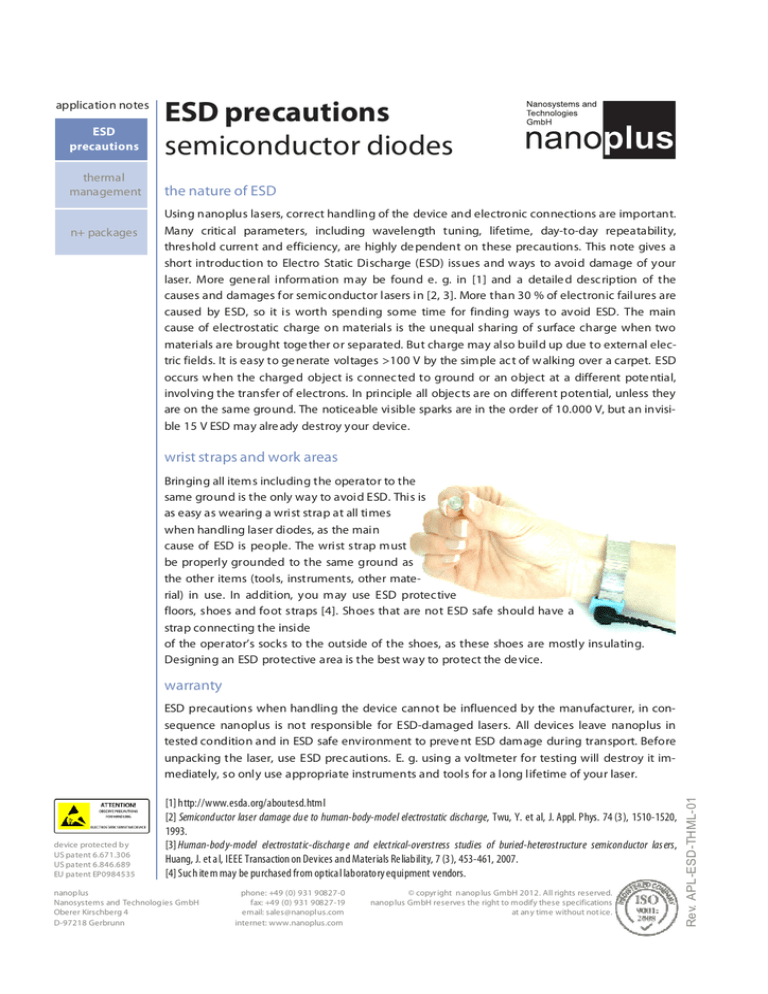
application notes
ESD
precautions
thermal
management
n+ packages
ESD precautions
semiconductor diodes
the nature of ESD
Using nanoplus lasers, correct handling of the device and electronic connections are important.
Many critical parameters, including wavelength tuning, lifetime, day-to-day repeatability,
threshold current and efficiency, are highly de pendent on these precautions. This note gives a
short introduction to Electro Static Discharge (ESD) issues and w ays to avoid damage of your
laser. More gene ral information may be found e. g. in [1] and a detaile d description of the
causes and damages for semiconductor lasers in [2, 3]. More than 30 % of electronic failures are
caused by ESD, so it is worth spending some time for finding ways to avoid ESD. The main
cause of electrostatic charge on materials is the unequal sharing of surface charge when two
materials are brought toge ther or separated. But charge may also build up due to external electric fields. It is easy to ge nerate voltages >100 V by the simple act of w alking over a carpet. ESD
occurs w hen the charged object is connected to ground or an object at a different pote ntial,
involving the transfer of electrons. In principle all objects are on different potential, unless they
are on the same ground. The noticeable visible sparks are in the order of 10.000 V, but an invisible 15 V ESD may alre ady destroy your device.
wrist straps and work areas
Bringing all items including the operator to the
same ground is the only way to avoid ESD. This is
as easy as wearing a wrist strap at all times
when handling laser diodes, as the main
cause of ESD is people. The wrist strap must
be properly grounded to the same ground as
the other items (tools, instruments, other material) in use. In addition, you may use ESD protective
floors, shoes and foot straps [4]. Shoes that are not ESD safe should have a
strap connecting the inside
of the operator’s socks to the outside of the shoes, as these shoes are mostly insulating.
Designing an ESD protective area is the best way to protect the de vice.
warranty
device protected by
US patent 6.671.306
US patent 6.846.689
EU patent EP0984535
[1] http://www.esda.org/aboutesd.html
[2] Semiconductor laser damage due to human-body-model electrostatic discharge, Twu, Y. et al, J. Appl. Phys. 74 (3), 1510-1520,
1993.
[3] Human-body-model electrostatic-discharge and electrical-overstress studies of buried-heterostructure semiconductor las ers,
Huang, J. et al, IEEE Transaction on Devices and Materials Reliability, 7 (3), 453-461, 2007.
[4] Such item may be purchased from optical laboratory equipment vendors.
nanoplus
Nanosystems and Technolog ies GmbH
Oberer Kirschberg 4
D-97218 Gerbrunn
phone: +49 (0) 931 90827-0
fax: +49 (0) 931 90827-19
email: sales@nanoplus.com
internet: www.nanoplus.com
© copyr ight n anoplus GmbH 2012. All rights reserved.
nanoplus GmbH reserves the right to modify these specifications
at an y time without not ice.
Rev. APL-ESD-THML-01
ESD precautions when handling the device cannot be influenced by the manufacturer, in consequence nanoplus is not responsible for ESD-damaged lasers. All devices leave nanoplus in
tested condition and in ESD safe environment to preve nt ESD damage during transport. Before
unpacking the laser, use ESD precautions. E. g. using a voltmeter for testing will destroy it immediately, so only use appropriate instruments and tools for a long lifetime of your laser.
application notes
ESD
precautions
thermal
management
n+ packages
thermal management
design considerations
general
Using nanoplus lasers, correct handling of the temperature control and thermal management
of your system are important. Many critical parameters, including wavelength tuning, lifetime,
day-to-day re peatability, threshold current and efficiency, are highly dependent on the laser
temperature. A temperature stability below 10 mK is desirable for most applications. In addition, DFB laser diodes tune their wavelength with temperature, so control of it is essential and
using the laser in the specified temperature range is necessary.
design suggestions
The de tails of the mounting are determined by considerations of how to keep the temperature
of the laser as stable as possible. However, because diode lasers and associated optics can be
much smaller and lighter than other types of lasers, the scale of the assembly is often quite different. The figure shows our TO5 and our Butterfly laser mount.
do not force the fiber
the closure head is not
suited for heat removal
the cap is not suited
for heat removal
never use
pins for
heat removal
nor for fixation
couple the bottom of the TO
header to a heat sink - heat
must always be removed from the
bottom
fix the package tightly to
your heat sink using the
four clearance holes
heat can only be remove d from the package bottom
warranty
device protected by
US patent 6.671.306
US patent 6.846.689
EU patent EP0984535
Thermal management of the device cannot be influence d by the manufacturer. In consequence, nanoplus cannot be responsible for thermally damaged lasers and any warranty is
void. All devices leave nanoplus in tested condition and in proper environme nt to prevent
damage during transport. Before unpacking the laser, consider thermal management and only
use appropriate instruments for a long lifetime of your laser.
nanoplus
Nanosystems and Technolog ies GmbH
Oberer Kirschberg 4
D-97218 Gerbrunn
phone: +49 (0) 931 90827-0
fax: +49 (0) 931 90827-19
email: sales@nanoplus.com
internet: www.nanoplus.com
© copyr ight n anoplus GmbH 2012. All rights reserved.
nanoplus GmbH reserves the right to modify these specifications
at an y time without not ice.
Rev. APL-ESD-THML-01
In the show n TO5 case, the laser-chip is soldere d on top of a heat spreader, which is mounted
to the TEC. The bottom of the TEC is attache d to the TO5 base plate of the heade r. Because of
thermal radiation and air curre nts, it is advisable to enclose the laser mount in some sort of container, which is also keeping dust out of the system and insulating it from vibrations. This TO5
package will not sufficiently dissipate the heat without further measures! So the heat must be
removed from the bottom of the TO5 package as shown in the picture. Use thermal grease only
in thin layers and consider long term behavior.
If you use a temperature controller, be sure to set its current limit below the maximum rating of
the TEC module. To avoid oscillations, set the values of your PID controller to match the thermal
load. Temperatures above 130 °C may damage the laser mount! Use a socke t for connecting the
pins to your circuit. If you want to solder a wire to the pins, use 280 °C as temperature for the
soldering-iron, and hold the iron to the pins for less than 3 sec. Poor the rmal management may
cause high temperatures which are damaging the bonding. Ask the manufacturer of the temperature controller for further advice if you feel unsure about the electronics. A proper heat sink
is available from nanoplus as accessory.



